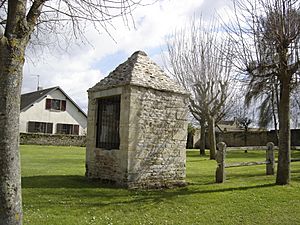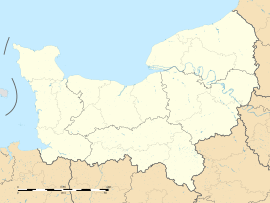Banville facts for kids
Quick facts for kids
Banville
|
||
|---|---|---|
|
A covered well in Banville
|
||
|
||
| Country | France | |
| Region | Normandy | |
| Department | Calvados | |
| Arrondissement | Bayeux | |
| Canton | Courseulles-sur-Mer | |
| Intercommunality | Seulles Terre et Mer | |
| Area
1
|
4.68 km2 (1.81 sq mi) | |
| Time zone | UTC+01:00 (CET) | |
| • Summer (DST) | UTC+02:00 (CEST) | |
| INSEE/Postal code |
14038 /14480
|
|
| Elevation | 2–53 m (6.6–173.9 ft) (avg. 25 m or 82 ft) |
|
| 1 French Land Register data, which excludes lakes, ponds, glaciers > 1 km2 (0.386 sq mi or 247 acres) and river estuaries. | ||
Banville is a small and charming village in the Calvados area of north-western France. It's part of the beautiful Normandy region. People who live here are called Banvillais or Banvillaises.
Contents
Where is Banville?
Banville is located in a part of France called Bessin. It's about 3 kilometers (2 miles) south-west of Courseulles-sur-Mer and 5 kilometers (3 miles) east of Crépon. You can get to Banville by taking the D12 road. This road goes through the village.
Most of the land around Banville is used for farming. There are also some houses where people live. The Seulles river flows along the eastern side of Banville. It then goes north to the English Channel at Courseulles-sur-Mer.
Nearby Towns and Villages
 |
Ver-sur-Mer | Graye-sur-Mer | Bernières-sur-Mer |  |
| Crépon | ||||
| Tierceville | Amblie | Reviers |
Banville's History
Banville played a part in a very important event called D-Day. This was when Allied forces invaded Normandy during World War II. Banville was only about 3 kilometers (2 miles) from Juno Beach. This was where Canadian soldiers landed on June 6, 1944.
The village of Banville was freed on that same day. It was liberated by a Canadian army group called the Royal Winnipeg Rifles.
How Many People Live in Banville?
Knowing how many people live in a place is called demography. In 2010, about 657 people lived in Banville. The number of people living in Banville has been counted regularly since 1793. This helps us see how the population has changed over time.
Culture and Old Buildings
Banville has many interesting old buildings and places. Some of these are even listed as historical monuments. This means they are very important to protect.
Historic Buildings to See
- The Reviers Bridge was built in the 1600s.
- The Hervot Farmhouse is at 12 rue du Bout du Haut. It was built in 1913.
- A Farmhouse at 25 Rue du Camp Romain dates back to the 1700s.
- A Notable's House at 8 Rue du Marché is also from the 1700s.
- A Lavoir (public laundry building) is on the Route de Reviers. It was built in the 1800s.
- A Chateau (a large country house or castle) was built in 1545.
- An old Girls' Primary School from the 1800s.
- The old Town Hall also from the 1800s.
- The Village itself has very old history, going back to the Stone Age.
- Many Houses built in the 1700s and 1800s.
Other Interesting Places
- The Roman Camp of La Burette is an ancient military camp.
Religious Buildings
Banville also has several old religious buildings. These are also listed as historical monuments.
- A Presbytery (a house for a priest) at 10 Rue du Bout du Haut from the 1700s.
- A Calvary (a cross or statue showing Jesus on the cross) on Route de Courseulles-Sur-Mer, built in 1912.
- The Parish Church of Saint-Lo from the 1700s.
The Church of Saint-Lo has many old and special items inside. These are also protected as historical objects.
- A Stole (a long cloth worn by priests) from the 1800s.
- A Ciborium (a cup for holding communion wafers) from the 1700s.
- A Monstrance (a special container for showing the communion wafer) from the 1800s.
- A Way of the Cross (pictures showing Jesus's journey to the cross) from the 1800s.
- A Chalice with Paten (a cup and plate used in church services) from the 1800s.
- Three Processional Banners (flags used in church parades) from the 1800s.
- A Painting called "Nativity" (showing the birth of Jesus) from the 1600s.
- A Statue of the Virgin Mary and child from the 1600s.
- A Statue of Saint Nicolas de Bari from the 1700s.
- A Cross showing Christ on the Cross from the 1700s.
- Two banks of Stalls (seats in a church) from the 1800s.
- A Paschal Candlestick (a large candle holder) from the 1800s.
- A Rood beam (a beam in a church with a cross on it) from the 1800s.
- A Baptismal font (a basin for baptisms) from the 1500s.
- Seven Stained glass windows showing the Seven Sacraments, from 1959.
- Six other Stained glass windows, also from 1959.
- All the Furniture in the Church.






